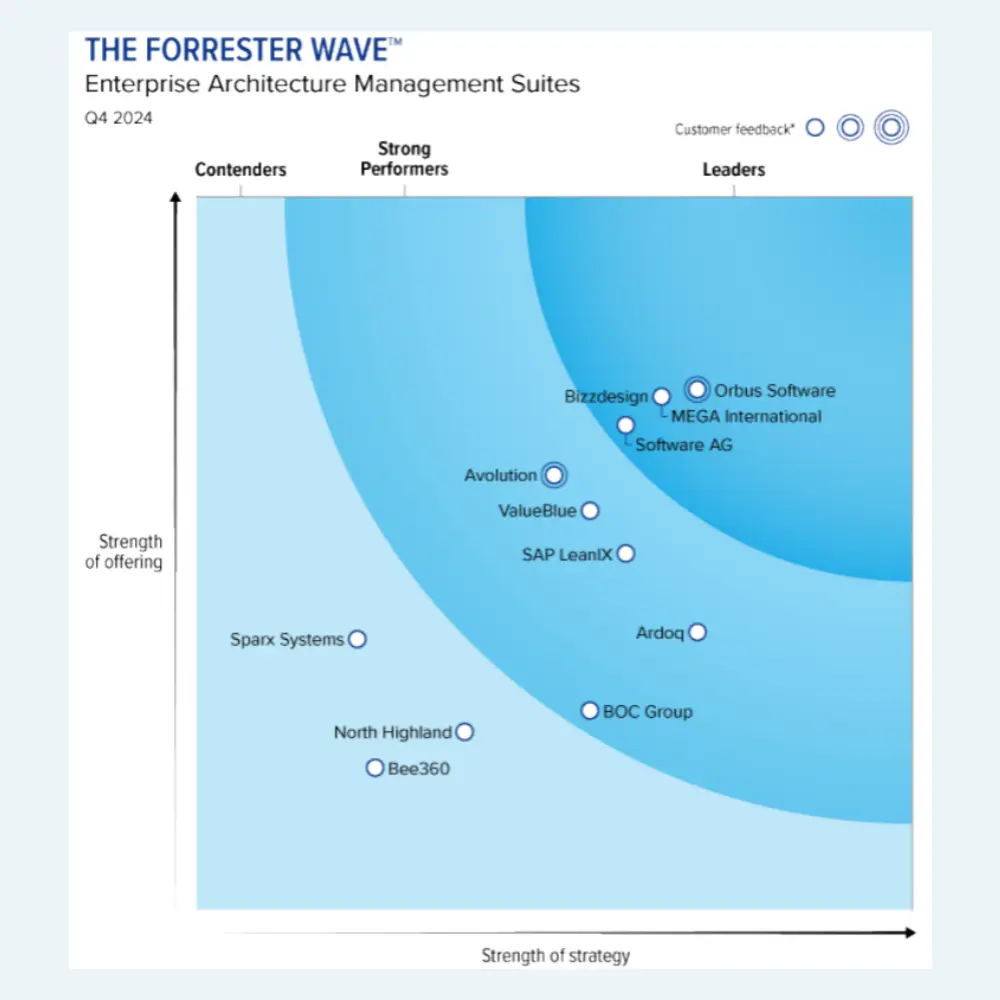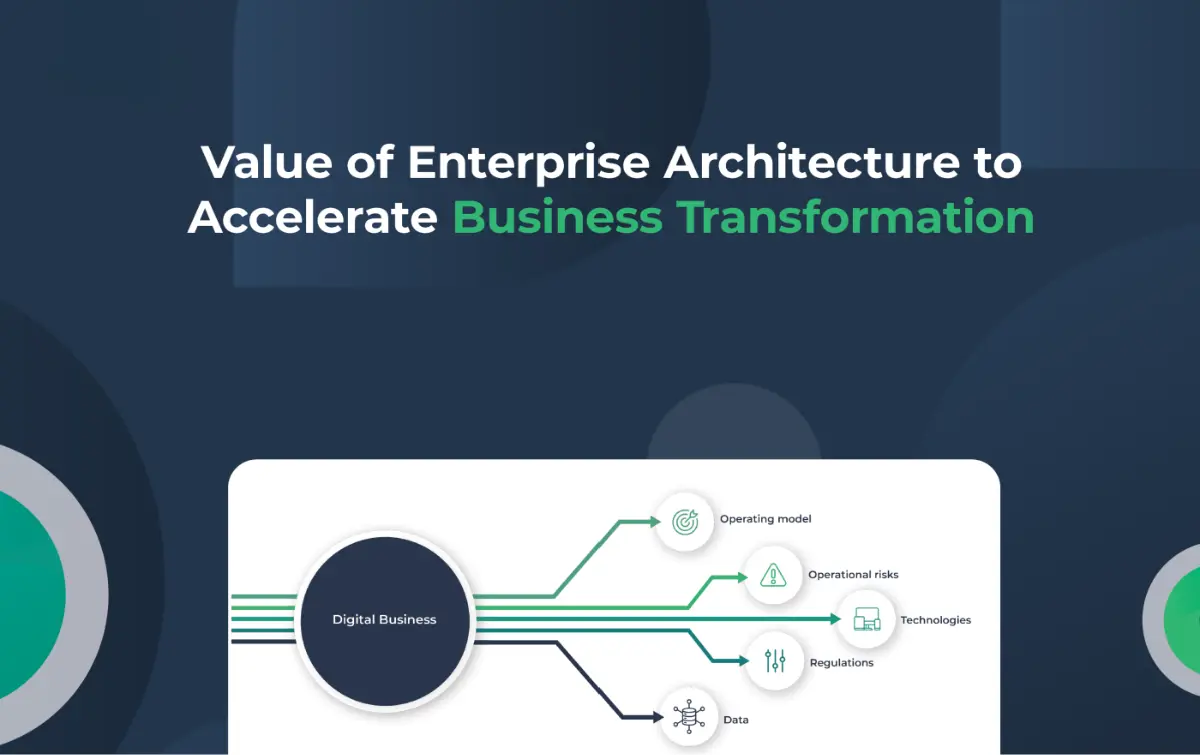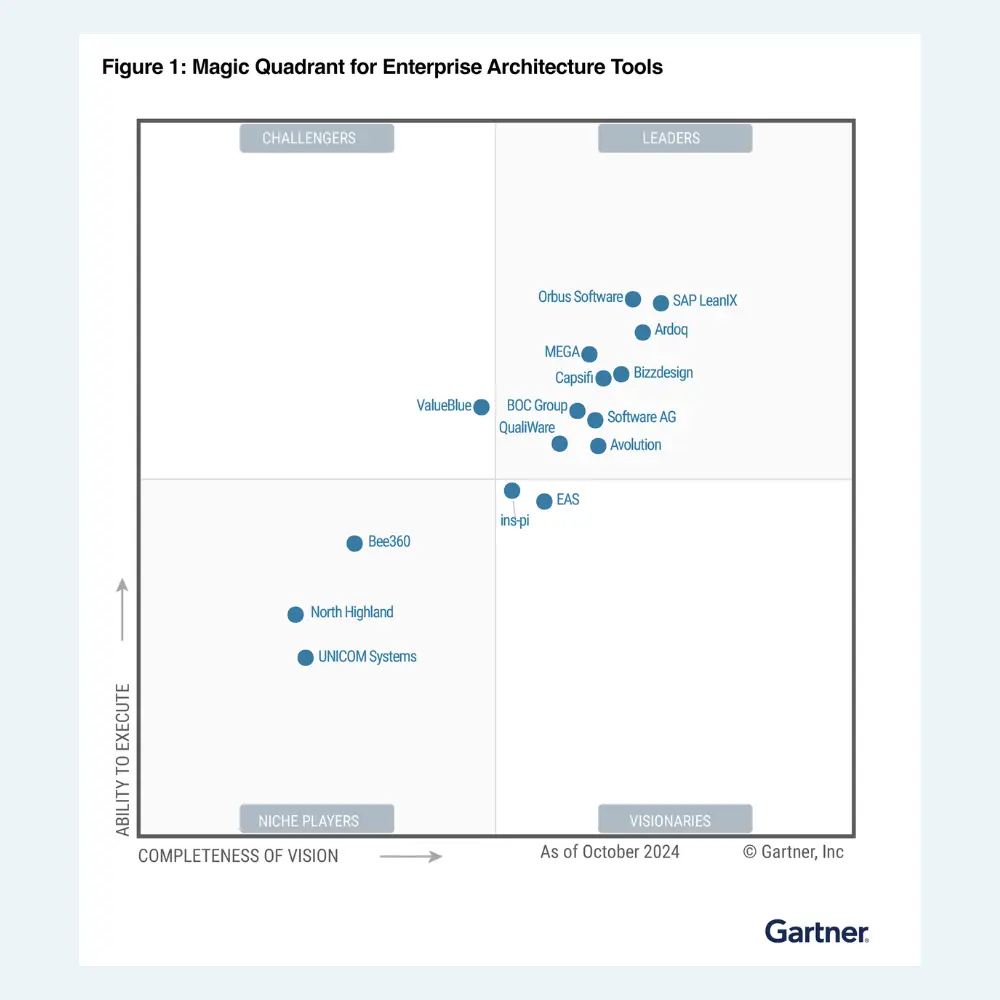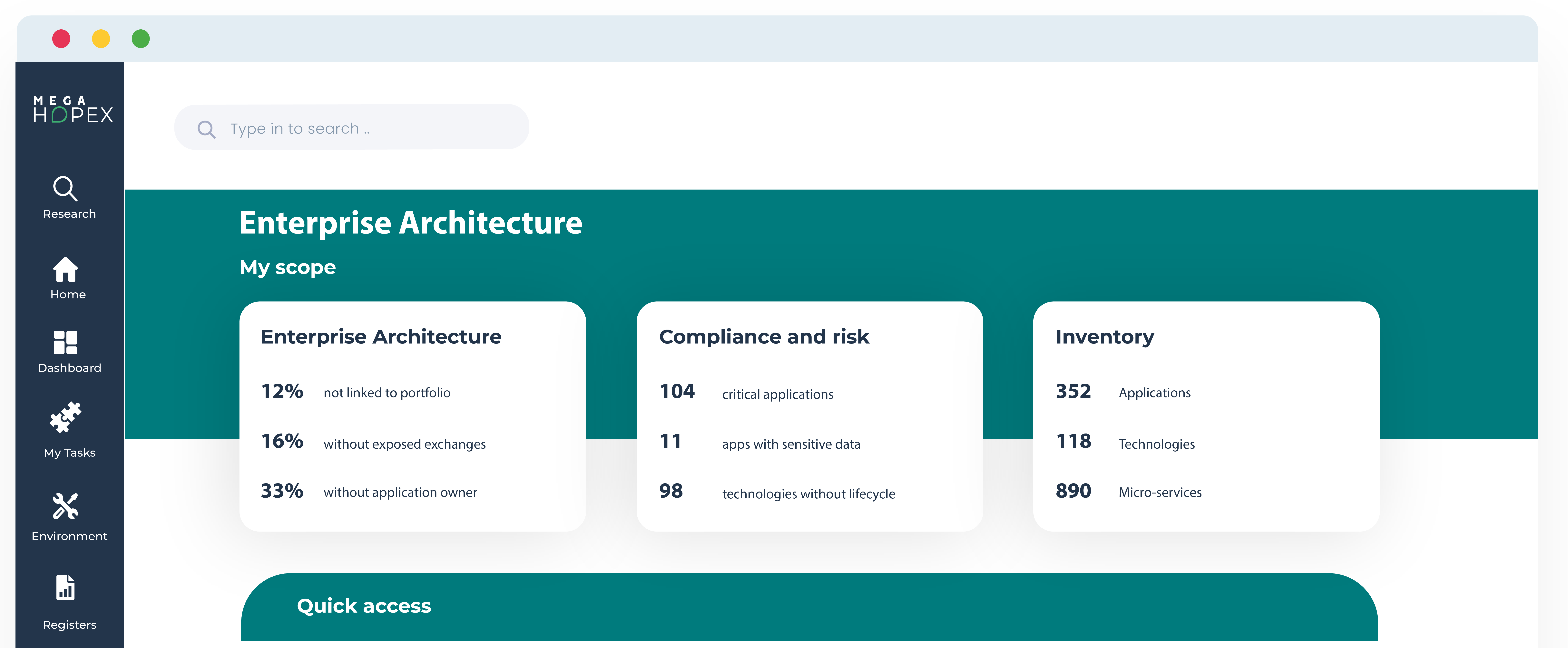
Challenges of Enterprise Architecture
Enterprise Architecture (EA) is fundamental to an organization's information technology (IT) strategy. It is pivotal in achieving business objectives by aligning technology capabilities with business needs. Nonetheless, the implementation of EA has its challenges.
EA is a dynamic and multifaceted discipline that requires a comprehensive grasp of an organization's business operations, technological infrastructures, and strategic aspirations. In this blog post, we will delve into the challenges of EA and the ensuing effects on organizational outcomes. Moreover, we will outline strategies organizations can employ to surmount these obstacles and realize their business ambitions.
The most common enterprise architecture challenges when attempting to implement an effective EA are as follows:
Despite the benefits of enterprise architecture, implementing an EA program can be challenging.
Here are some of the most common challenges that organizations may face when implementing EA:
Resistance to Change
Resistance to change is a significant challenge that organizations face when implementing enterprise architecture (EA). Organizations often operate in departmental silos, with each team working independently towards its goals. However, introducing EA requires breaking down these silos and fostering a culture of collaboration and transparency across the organization. This shift in mindset and working practices can be challenging for some employees, who may feel threatened by the changes.
Limited Resources
Implementing enterprise architecture (EA) requires a substantial investment of time, financial resources, and personnel. However, many organizations need help to allocate the necessary resources to this effort, either due to budgetary constraints or competing priorities with other projects. As a result, they may need more progress or take a piecemeal approach to implementation, which can hinder the effectiveness of their EA initiatives. Organizations must prioritize EA as a strategic initiative to address this challenge and allocate sufficient resources to ensure its success.
Complex IT Environments
Enterprise architecture (EA) initiatives often require significant changes to an organization's IT infrastructure, which can be daunting, especially for those with complex IT environments. Coordinating changes across multiple systems and ensuring compatibility can pose a significant challenge. Organizations must adopt a well-planned and coordinated approach to EA implementation to overcome this challenge. This approach should involve thoroughly analyzing the existing IT infrastructure, identifying potential compatibility issues, and developing a comprehensive implementation plan that incorporates appropriate testing and validation procedures. Implementing these procedures gradually over time is important while closely monitoring and assessing their effectiveness.
Lack of standards
EA requires standardized processes and procedures across the organization. Still, many organizations need to improve this EA, which requires standardized processes and procedures, but many also need these standards. Developing and implementing standards can be lengthy and challenging, particularly in organizations with a history of decentralized decision-making. To address this challenge, organizations must establish a clear and consistent set of standards and guidelines aligned with their overall business objectives.
Lack of Clarity and Consistency
EA requires managing complex concepts, which may be subject to misinterpretation and lead to errors or a lack of clarity and consistency. Then, achieving the program's desired outcomes can take time and effort. Stakeholders may need help applying the EA framework in their work, leading to inefficiencies or mistakes.
To overcome this challenge, it's crucial to establish clear governance and standards for the EA framework. This includes developing processes and methodologies for EA implementation and management and defining stakeholder roles and responsibilities.
Lack of Skills and Expertise
Finally, a lack of skills and expertise in EA can be a significant challenge. Effective EA requires various specialized skills, including architecture design, data modeling, and technology infrastructure management. With access to these skills, building and maintaining an effective EA program can be more accessible.
Enterprise architecture faces several challenges in the context of digital transformation.
Organizations must overcome The following critical challenges to achieve successful digital transformation through EA.

- Agility: With rapid changes in technology, business models, and customer expectations, organizations need to be agile and adaptable to keep up with the pace of digital transformation. EA should be flexible and responsive to change, allowing organizations to quickly adapt to new challenges and opportunities.
- Complexity: Digital transformation often involves integrating new technologies, processes, and systems with existing ones. This can result in a complex IT landscape that is difficult to manage and maintain. EA should provide a clear and holistic view of the organization's IT landscape, enabling organizations to manage complexity effectively.
- Collaboration: Digital transformation requires collaboration across business units, functions, and stakeholders. EA should facilitate collaboration by providing a shared understanding of the organization's goals, strategies, and IT landscape. It should also encourage open communication and cooperation between different teams and stakeholders.
- Innovation: Digital transformation requires innovation and creativity to identify new opportunities and solutions. EA should encourage innovation by providing a flexible and adaptable IT landscape that supports experimentation and innovation.
- Security: Digital transformation can increase the organization's exposure to security risks, such as cyber-attacks and data breaches. EA should prioritize safety by implementing robust security measures and ensuring all IT systems and processes comply with relevant regulations and standards.
Strategies to Overcome the Challenges of Enterprise Architecture
While the challenges of implementing effective enterprise architecture (EA) can seem daunting, there are strategies that businesses can use to overcome them. Here are some tips for addressing the most common challenges:
Build a Strong Business Case
To secure executive support for EA, it's crucial to build a strong business case demonstrating EA's value and benefits. This should clearly explain how EA can support business goals, improve operations, and reduce costs.
Foster Collaboration Between Business and IT
Fostering collaboration between business and IT is essential to ensure alignment. This includes encouraging communication and cooperation between business and IT stakeholders and developing shared goals and objectives.
Address Resistance to Change
Engaging stakeholders early and often in the EA implementation process is essential to overcome resistance to change. This includes communicating the vision and benefits of EA and involving stakeholders in developing and implementing the EA framework.
Allocate Sufficient Resources
To ensure the necessary resources are allocated to the EA effort, creating a comprehensive plan outlining its costs and benefits is crucial. Senior leadership should present this plan to secure their support and funding. It's also essential to prioritize the EA effort and allocate the necessary personnel and technology resources to ensure success.
Simplify IT Infrastructure
Simplifying IT infrastructure is essential for effective EA implementation. This can involve consolidating systems and applications to reduce complexity and ensure compatibility. Standardizing processes and procedures also ensures consistency and reduces the risk of errors.
Develop Standards
Developing and implementing standards can be lengthy but essential for successful EA implementation. This can involve creating a governance structure to oversee the EA effort and define processes, procedures, and technology standards. Businesses can ensure buy-in and adoption across the organization by involving stakeholders in developing these standards.
Establish Clear Governance and Standards
To ensure consistency and clarity in the EA framework, it's crucial to establish clear governance and standards. This includes defining roles and responsibilities and developing processes and methodologies for EA implementation and management.
Use Tools and Processes to Manage Complexity
It's important to use practical tools and processes to manage the complexity of large-scale technology infrastructure. This includes using technology to automate tasks, improve efficiency, and develop standardized strategies and methodologies for managing complex systems.
Invest in Training and Development
Investing in training and development for EA stakeholders is essential to overcome a lack of skills and expertise. This includes providing access to training and certification programs and offering hands-on experience and mentorship opportunities.
Summary
By following these strategies, businesses can overcome the challenges of implementing effective EA and reap the benefits of streamlined processes, reduced costs, and improved alignment with strategic goals. With the right plan, EA can be a powerful tool for driving long-term success.
FAQs
Some of the biggest challenges facing organizations when implementing EA include getting buy-in from business stakeholders, managing the governance of the EA program, aligning technology with business goals, and ensuring that EA frameworks support the enterprise.
The challenges of enterprise architecture can vary in different organizations, but some of the most common ones include:
- Lack of stakeholder buy-in
- Inability to align EA with business goals
- Ineffective governance of EA
- Difficulty in deciding on what EA frameworks to use
- Inability to keep up with the digital transformation
Enterprise systems are complex software packages integrating different business functions, such as accounting, human resources, customer relations, supply chain management, and production. While these systems can help organizations streamline their processes, save costs, and increase efficiency, they pose several challenges.
For instance, selecting the right enterprise system for a specific organization can be daunting, as each system has strengths and limitations. Moreover, implementing an enterprise system requires significant resources and time, as well as the cooperation of different departments and users.
Adoption can also be challenging, as employees may resist changes to their daily work routines or need help to adapt to the new system's interface and workflows. Finally, maintaining the system may require ongoing updates, patches, and technical support, which can incur additional costs and disruptions. Therefore, organizations need to plan carefully, communicate effectively, and prioritize user training and support to maximize the benefits of their enterprise systems.
Enterprise architecture can fail for several reasons. One of the primary causes is a need for more clarity and understanding of the goals and objectives of the EA effort. Often, there is a disconnect between what the organization needs and what the enterprise architects deliver. This can lead to confusion, inefficiencies, and an inability to achieve the desired outcomes of the EA program.
One contributing factor to the failure of EA programs is the absence of a comprehensive and collaborative approach. The EA framework lacks cohesiveness and consistency when business units operate independently without sharing their architectures with other departments.
This can lead to inefficiencies such as redundancy, duplicated efforts, and other obstacles that impede progress and result in poor outcomes.
Inadequate governance and management of EA projects can result in poor outcomes and a lack of adoption. This can lead to delays, misunderstandings, and, ultimately, failure to achieve the desired outcomes of the EA program. With proper governance and management, EA initiatives can become cohesive, with clear responsibilities and better communication.
The value of Enterprise Architecture to accelerate business transformation
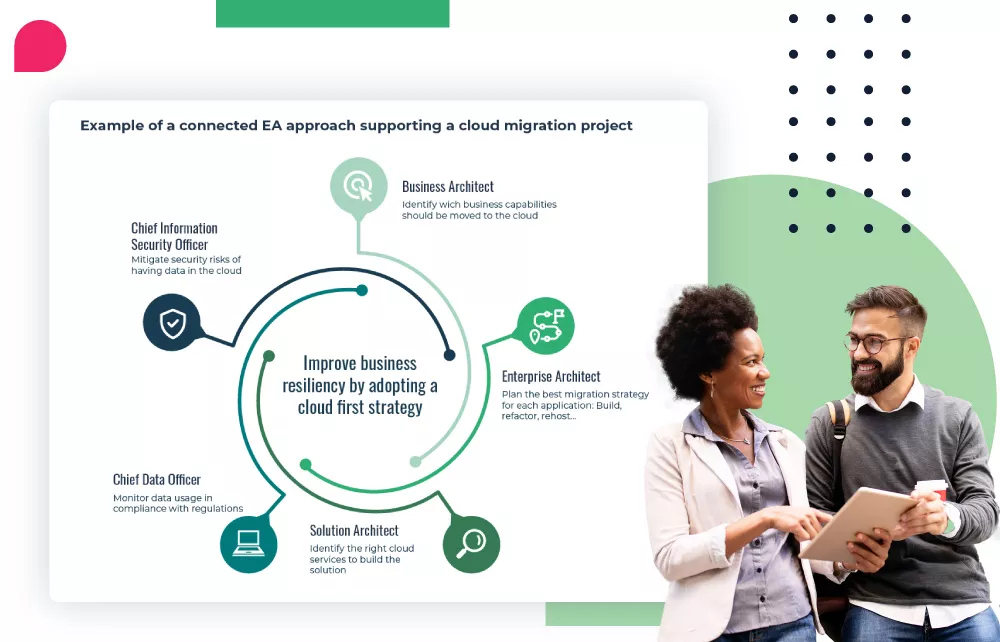
Access this white paper to learn:
- The evolution of the enterprise architecture practice
- How to Deliver Value through a Connected Enterprise Architecture Practice
- Strategies for Adopting a Business-Outcome-Driven Approach
- How to Use Data-Driven Tools to Enhance Your Enterprise Architecture Connectivity
Enterprise Architecture Related Content
Shift from a documentation tool to an operational tool and accelerate business transformation
MEGA HOPEX for Enterprise Architecture
Request a demonstration of HOPEX for EA, and see how you can have immediate value of your projects.







